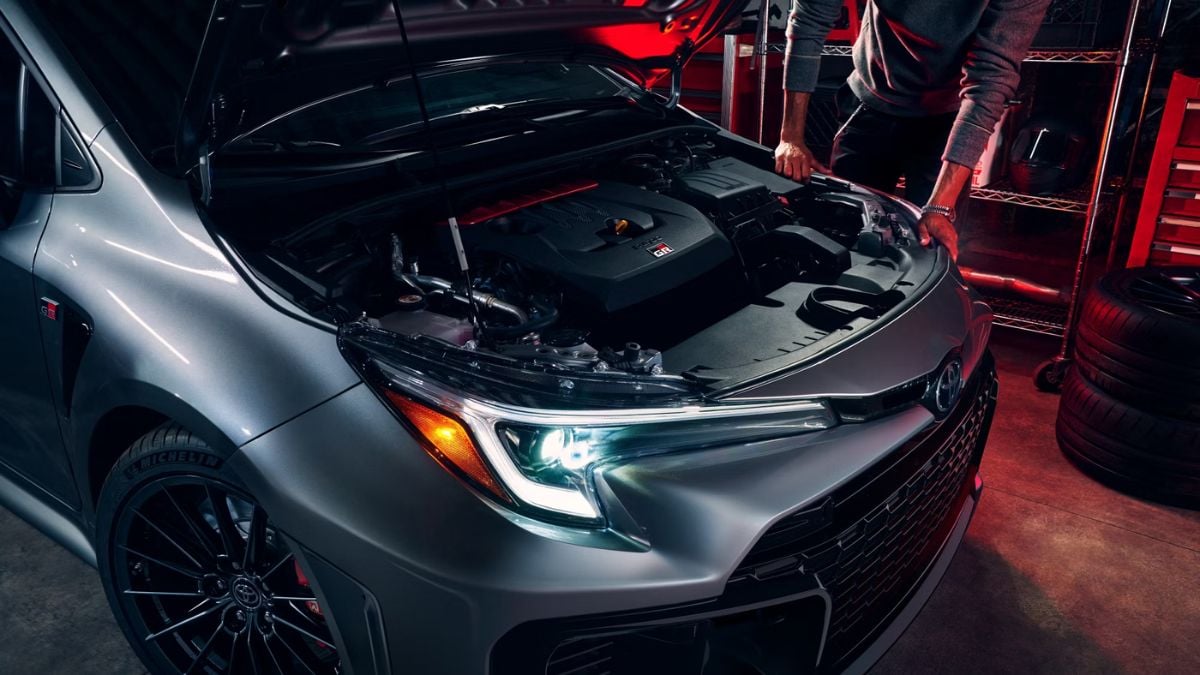It’s hard not to admire the Toyota GR Corolla with its lightweight, aggressive, and one of the most exciting drivetrains that Toyota has delivered to the masses. But sometimes, even the most promising cars can stumble in unexpected ways. That’s what caught my attention in the "2023+ Toyota GR Corolla Group" on Facebook this morning, where Amritpal Sohal shared their experience of how a smooth morning drive in the 2025 GR Corolla was suddenly interrupted by a check engine light. A quick stop at O’Reilly Auto Parts confirmed the culprit: the dreaded P2C90 code, which has been a light that’s becoming familiar in GR Corolla owner circles.
Amritpal wrote, "So far so good with my ‘25 GR Corolla, but the inevitable did unfortunately happen today. I was driving to work and I was hit with a check engine light. I drove the car to the nearest O'Reilly’s to see if I could use their scanner. And it turns out the infamous P2C90 was the issue. I will be taking it to Toyota on Monday, has anyone else’s 2025 gotten this issue?"
This post wasn’t the first time I had seen owners bring up this particular code. The GR Corolla, while widely praised for its thrilling driving dynamics, is no stranger to growing pains as the platform matures. Toyota purists and first-time GR buyers alike have been grappling with the reality that even enthusiast-grade performance machines aren’t immune to quirks, especially when modern emissions systems and crankcase ventilation sensors are involved.
What Does Code P2C90 Actually Mean?
For those unfamiliar, the P2C90 code relates to the crankcase ventilation system. More specifically, it’s often interpreted as "Hose 'A' Disconnected" or a fault within the Positive Crankcase Ventilation (PCV) subsystem. It essentially means that the ECU is detecting an imbalance in expected air pressure or flow within the engine's closed-loop breathing system. It’s designed to reduce emissions and control blow-by gases, and when something as simple as a vacuum irregularity occurs, the car logs a fault.
This code is most commonly triggered by modified vehicles, especially those with aftermarket intakes, catch cans, or even filter swaps that alter airflow dynamics just enough to set off the sensitive sensors. But in Amritpal’s case, and in several others we’ll explore, the cars are completely stock. This raises new questions about whether something more systemic might be at play.

Other Owners Speaking Up
Austin Mellene chimed in shortly after Amritpal’s post, sharing, "I just got the same code. I literally was driving home casually. 2025 P+."
This mirrors a trend it seems: the P2C90 code isn’t just showing up under track conditions or after spirited driving, but during everyday commutes as well. That suggests the issue may not necessarily stem from driver behavior or extreme operating conditions, but rather from a potential calibration or component-related problem.
Reese Frederick Herber added a particularly eye-opening comment: "Every 200-300 miles although the car is bone stock."
That kind of consistency is especially concerning. A recurring P2C90 warning on an unmodified vehicle implies a pattern that Toyota should be actively investigating, especially as the GR Corolla gains more mainstream traction. This could certainly diminish confidence in the platform’s long-term durability.
Ynoh Joshua de Guzman offered a bit of reassurance for those currently facing the issue: "Got it a week ago. The dealer ordered the part needed and will replace it on Monday. All covered under warranty."
So at least Toyota is addressing it through warranty channels, which tells us they’re aware of the problem and have a fix on hand. What’s not clear, however, is whether they’re taking a proactive approach in updating components or calibrations to prevent the issue from spreading across more units.
Then there’s a counterpoint from Kevin Desirello, who brought some valuable perspective from the dealership side: "I’ve had a ‘23 since it was brand new and had no lights ever although I drive the heck out of it. It has 31k miles on the clock. It’s all stock aside from a Tom’s drop in the air filter and the center exhaust valve mod. I'm a master tech at a dealership and don’t see all of these problems coming in like I see on the forums."
Kevin’s comment highlights something every enthusiast should remember: sometimes forum chatter and Facebook groups can exaggerate issues that may not actually be widespread at a dealership level. Still, when codes like P2C90 show up repeatedly in a short span of time across stock vehicles, it’s hard not to take notice.
Could This Be the GR Corolla's First Real Reliability Hiccup?
Despite these scattered issues, there’s no denying the GR Corolla remains one of the most thrilling performance hatches available today. Its following is partly due to Toyota's willingness to give enthusiasts something raw, manual, and genuinely exciting. Some owners are even calling it the most fun car they’ve ever had.
But the emerging talk around the P2C90 code shows that even cars built with passion aren't immune to modern-day complexity. Emissions compliance and onboard diagnostics are more sensitive than ever, and that means that even small calibration variances can trip a code. What makes it more frustrating is the lack of clear root causes in stock vehicles.
This isn’t the first time GR Corolla owners have questioned long-term reliability, either. Some have even begun trading their GR Corollas with less than 10,000 miles, citing build concerns or unexpected issues. While that doesn’t define the model, it adds context to the worries surrounding persistent warning lights.
A Bigger Picture Behind the GR Badge
Toyota has been teasing the future of the GR lineup, including a 2026 GR Corolla that promises some major surprises. It’s likely that some of the lessons learned from the current generation, including those like the P2C90 code, will play a role in shaping what comes next.
Part of the appeal of the GR Corolla is its connection to Toyota's legendary lineup of iconic performance cars, and that means a certain level of trust comes baked in. Enthusiasts expect a product that can take a beating, perform well, and stay reliable. If fault codes start showing up more often on completely unmodified cars, Toyota risks chipping away at that image.
So that's why I believe this conversation is important not just because of the code itself, but what it represents. The GR Corolla was Toyota's gift to the enthusiast world—a signal that they still cared about driving joy. But with that gift comes the responsibility of delivering a product that lives up to its purpose.
At the same time, I appreciate that many dealerships seem responsive, and Toyota's warranty is catching the issue early. It’s also encouraging to see that it’s not yet a widespread failure point, but rather a common quirk that could be managed with calibration updates or improved parts in the future. Either way, this feels like one of those moments where the enthusiast community acts as Toyota’s early warning system, and I hope the company is listening.
Key Takeaways
- The P2C90 fault code is real, and it’s not limited to modified cars. Stock owners are seeing this warning, often without triggering events.
- Toyota is covering it under warranty, which is a good sign—but not a long-term fix for those hoping to avoid repeat visits.
- Some owners experience it as a one-off, while others report recurring alerts every few hundred miles.
- It’s worth asking your dealer to inspect your PCV system proactively if you notice any warning lights or rough idle.
- Not every GR Corolla is affected, and dealership techs don’t always see the same volume of issues that online forums do.
What Do You Think?
Are you worried about these kinds of early warning codes, or do you see them as something benign?
And have any of you experienced the P2C90 code on your GR Corolla? If so, how did your dealer handle it?
Don't hesitate to share your story below. Every real-world experience helps paint a clearer picture of what owners are actually facing.
Aram Krajekian is a young automotive journalist bringing a fresh perspective to his coverage of the evolving automotive landscape. Follow Aram on X and LinkedIn for daily news coverage about cars.
Image Sources: The “2023+ Toyota GR Corolla Group” public Facebook group and Toyota’s gallery, respectively.













Comments
Sxth intake in my 2025 and…
Permalink
Sxth intake in my 2025 and the owner and I are working to test different 3d printed parts to fix the code. Curious what Toyota did for Joshua you mentioned. Was it a PCV tube they swapped? How can I get my hands on one? No dealerships will help me with the intake. They just dismiss me.
Hey Chris. I read some of…
Permalink
In reply to Sxth intake in my 2025 and… by Chris A (not verified)
Hey Chris. I read some of the comments under his post and it seems one of them got their purge vacuum valve replaced by Toyota. Hope this helps.
I am about to order my 2025…
Permalink
I am about to order my 2025 GR any day and have been reading everything I can about probs. They say 3 months from order date. It was 6 to 12 months. Is this because of the the factory in the UK starting to build them. I think I would want one built in Japan
Thanks for sharing your…
Permalink
In reply to I am about to order my 2025… by Ian (not verified)
Thanks for sharing your upcoming order plans Ian. If you’re set on a Japan-built GR, definitely let your dealer know early so they track production origin and can accommodate preferences if it's possible.
It was a loose airbox for me…
Permalink
It was a loose airbox for me. Completely closed the lid and it fixed code. Check the rear tabs are engaged
That’s super helpful John…
Permalink
In reply to It was a loose airbox for me… by John (not verified)
That’s super helpful John. Thanks for sharing. It's an easy thing to miss, and I'm hoping that tip helps others with the same code.